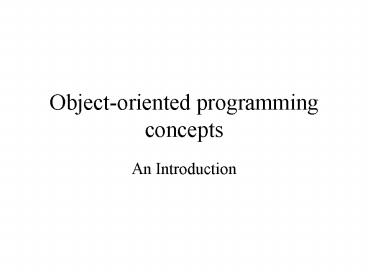Object-oriented programming concepts - PowerPoint PPT Presentation
Title:
Object-oriented programming concepts
Description:
Object-oriented programming concepts An Introduction – PowerPoint PPT presentation
Number of Views:32
Avg rating:3.0/5.0
Title: Object-oriented programming concepts
1
Object-oriented programming concepts
- An Introduction
2
Programs Objects
- Program consists of a set of interacting objects
- Object comprised of data its associated
operations represents some tangible or
intangible concept in programs problem domain - Examples
- Bank account
- Robot
- Song
3
Classes
- Class defines characteristics of an object to be
created - Dictates what object can cannot do
- Object is instance of class
- Can create many instances of a class
- To accomplish tasks in a program, we tap into
capabilities and characteristics of objects
classes - Classes and objects have two different kinds of
members methods and data
4
Messages and Methods
- Message a single program instruction that
requests a particular task to be performed calls
on a class or object to execute a method - Method the set of instructions that will be
performed in response to a message the
implementation of an algorithm
5
Arguments
- Argument a data value (expression) we pass along
with a message - Supplies the method with the raw material we need
it to process - Examples
- amount of money to set for minimum balance
- amount to be withdrawn or deposited
- distance for robot to travel
- angle of turn
- volume at which to play song
6
Data members
- Data members information held/manipulated by an
object or class - Class definition lists the types of data values
each of its instances can contain can be - Constant a data value that is set at its
definition and cannot be changed during the run
of a program (example the pitch frequency of a
particular musical note) - Variable a data value that may or may not be set
at definition, but which may be changed (account
balance, robot speed)
7
Data members
- Class data value single value shared by all
instances of class (minimum balance, maximum
speed) - Instance data value unique value held by
particular object (my account balance, your
robots current location, the length of a song)
8
Inheritance
- Inheritance mechanism that allows classes that
share common characteristics to be defined as
extensions of another class - Superclass class that contains definitions of
common characteristics also called parent class - Subclass class that is derived from a
superclass contains specialized characteristics
also called child class
9
Inheritance
- Child classes inherit common characteristics from
parent classes, but differ from each other in
some specialized way examples - All bank accounts have a balance, but a savings
account may pay interest whereas a checking
account may not - All songs contain a set of notes, but we can
differentiate purely instrumental songs from
songs with lyrics - An inheritance hierarchy can be created in which
a subclass becomes a superclass for other
subclasses
10
Software life cycle
- Software life cycle sequence of stages from
conception to working program (and beyond)
stages include - Analysis
- Design
- Coding
- Operation/Maintenance
11
Software life cycle
- Analysis feasibility study to see if problem is
solvable result is requirements specification
that describes program features in a verifiable
form - Design turn requirements specification into a
set of classes that fulfill the requirements - Coding implement design by writing a program (in
Java or some other programming language) a.k.a.
implementation phase
12
Sub-stages of implementation
- Testing run program with sample data to verify
its compliance with specification (correctness) - Debugging elimination of programming errors
found through program testing - Types of errors
- Syntax prevent program from compiling violation
of programming language rules - Semantic program compiles and runs, but produces
incorrect results
13
Operation/Maintenance Phase
- In the real world, this is the longest phase
- Program is put into production changes may be
required over time - An important goal of programming is to write code
that not only works, but is easily maintained































